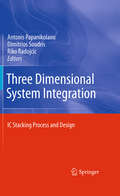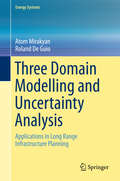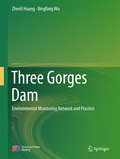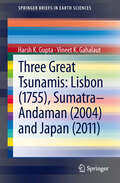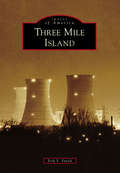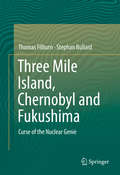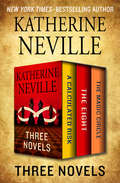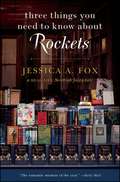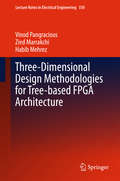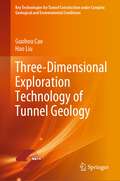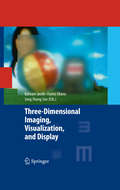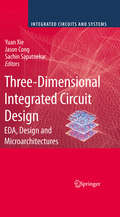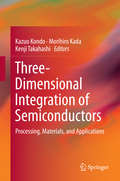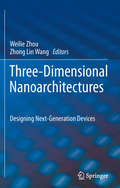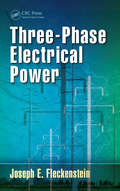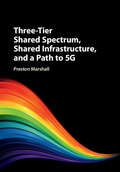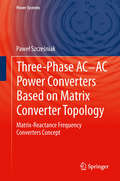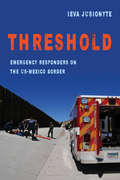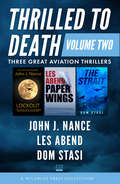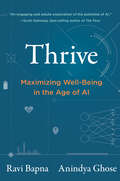- Table View
- List View
Three Dimensional System Integration
by Antonis Papanikolaou Riko Radojcic Dimitrios SoudrisThree-dimensional (3D) integrated circuit (IC) stacking is the next big step in electronic system integration. It enables packing more functionality, as well as integration of heterogeneous materials, devices, and signals, in the same space (volume). This results in consumer electronics (e.g., mobile, handheld devices) which can run more powerful applications, such as full-length movies and 3D games, with longer battery life. This technology is so promising that it is expected to be a mainstream technology a few years from now, less than 10-15 years from its original conception. To achieve this type of end product, changes in the entire manufacturing and design process of electronic systems are taking place. This book provides readers with an accessible tutorial on a broad range of topics essential to the non-expert in 3D System Integration. It is an invaluable resource for anybody in need of an overview of the 3D manufacturing and design chain.
Three Domain Modelling and Uncertainty Analysis
by Atom Mirakyan Roland De GuioThis book examines in detail the planning and modelling of local infrastructure like energy systems, including the complexities resulting from various uncertainties. Readers will discover the individual steps involved in infrastructure planning in cities and territories, as well as the primary requirements and supporting quality factors. Further topics covered concern the field of uncertainty and its synergies with infrastructure planning. Theories, methodological backgrounds and concrete case studies will not only help readers to understand the proposed methodologies for modelling and uncertainty analysis, but will also show them how these approaches are implemented in practice.
Three Farms: Making Milk, Meat, and Money from the American Soil
by Mark KramerThree representative profiles of farmers across the nation--a Massachusetts dairy farmer, an Iowa farmer devoted to raising corn and hogs, and a California agribusiness--document the plight of America's small farmers and their vanishing way of life.
Three Gorges Dam
by Zhenli Huang Bingfang WuThis is the first English book talking about the Three Gorges Project Eco-Environmental Monitoring System (TGPEEMS). It presents lessons learned in construction of large dam projects at home and abroad in this field, identifies existing problems before suggesting a scientific improvement plan. and, most importantly, it studies modification of the TGPEEMS to adapt it to the changing situation after the impoundment of the reservoir, and provides an essential overview of measures and progress in the ecological and environmental protection for the ongoing project. As such, it offers a valuable reference guide for both researchers and environmental decision-makers. Prof. Zhenli Huang works at the National Research Center for Sustainable Hydropower Research, China Institute of Water Resources and Hydropower Research. Prof. Bingfang Wu works at the Institute of Remote Sensing Applications, Chinese Academy of Sciences, China.
Three Great Tsunamis: Lisbon (1755), Sumatra-Andaman (2004) and Japan (2011)
by Harsh K. Gupta Vineet K. GahalautTsunamis are primarily caused by earthquakes. Under favourable geological conditions, when a large earthquake occurs below the sea bed and the resultant rupture causes a vertical displacement of the ocean bed, the entire column of water above it is displaced, causing a tsunami. In the ocean, tsunamis do not reach great heights but can travel at velocities of up to 1000 km/hour. As a tsunami reaches shallow sea depths, there is a decrease in its velocity and an increase in its height. Tsunamis are known to have reached heights of several tens of meters and inundate several kilometres inland from the shore. Tsunamis can also be caused by displacement of substantial amounts of water by landslides, volcanic eruptions, glacier calving and rarely by meteorite impacts and nuclear tests in the ocean. In this SpringerBrief, the causes of tsunamis, their intensity and magnitude scales, global distribution and a list of major tsunamis are provided. The three great tsunamis of 1755, 2004 and 2011are presented in detail. The 1755 tsunami caused by the Lisbon earthquake, now estimated to range from Mw 8.5 to 9.0, was the most damaging tsunami ever in the Atlantic ocean. It claimed an estimated 100,000 human lives and caused wide-spread damage. The 2004 Sumatra Andaman Mw 9.1 earthquake and the resultant tsunami were the deadliest ever to hit the globe, claiming over 230,000 human lives and causing wide-spread financial losses in several south and south-east Asian countries. The 2011 Mw 9.0 Tohoku-Oki earthquake and the resultant tsunami were a surprise to the seismologists in Japan and around the globe. The height of the tsunami far exceeded the estimated heights. It claimed about 20,000 human lives. The tsunami also caused nuclear accidents. This earthquake has given rise to a global debate on how to estimate the maximum size of an earthquake in a given region and the safety of nuclear power plants in coastal regions. This Brief also includes a description of key components of tsunami warning centres, progress in deploying tsunami watch and warning facilities globally, tsunami advisories and their communication, and the way forward.
Three Mile Island (Images of America)
by Erik V. FasickConstruction of the Unit 1 reactor began on Three Mile Island in May 1968, with the production of commercial electricity beginning in 1974. Approval for the construction of the Unit 2 reactor was granted in November 1969, and it was only producing commercial electricity for less than 90 days when on March 28, 1979, a loud roar erupted from the nuclear power plant that shook windows and awakened residents in the communities on both sides of the Susquehanna River. This loud warning was the result of a series of mechanical and human errors that contributed towards a partial meltdown of the Unit 2 reactor and the most severe nuclear power accident in the history of the United States. In the days that followed, many residents of the surrounding communities left their homes and possessions out of fear of radioactive plumes, meltdowns, and exploding hydrogen bubbles. Those who remained behind faced anxiety and uncertainty, as information flowing from the power plant circumvented the truth and lacked credibility. As the Unit 2 reactor cooled, protests and court battles ensued as attempts were made to restart the power plant's dormant Unit 1 reactor. The Three Mile Island Nuclear Generating Station symbolized the fight over nuclear power as a safe and viable energy source in the late 20th century.
Three Mile Island, Chernobyl and Fukushima
by Thomas Filburn Stephan BullardThis book will examine the three most well-known and socially important nuclear accidents (Fukushima, Chernobyl and Three Mile Island). Each of these accidents had significant, yet dramatically different, human and environmental impacts. Unique factors helped shaped the overall pattern and scale of each disaster, but a major contributing factor was the different designs used for each reactor. Fukushima was a boiling water reactor (BWR), Chernobyl was a graphite moderated boiling water reactor, and TMI was a pressurized water reactor (PWR). The book will predominantly focus on how these 3 distinctly different reactor designs came into being and how the different design types contributed to each disaster. The book will trace the history of nuclear power and the development of each reactor type. It will examine how GE's work with a sodium cooled design did not fare well with the Navy, and lead GE to promulgate the BWR design. It will examine the Russian atomic bomb program, its use of graphite moderated reactors (some borrowed from the first US plutonium production installations) and their design modifications to create power production units. It will trace the history of reactor development in the US that lead the navy to select the PWR design, and the PWR to become the design for nearly 2/3 of all US commercial reactors. In sum, the book uses the three major nuclear accidents as a lens to trace the technological history of nuclear energy production and to link these developmental advances with long-term (and often unanticipated) societal and environmental consequences.
Three Novels: A Calculated Risk, The Eight, and The Magic Circle
by Katherine NevilleA trio of heart-stopping thrillers from the New York Times–bestselling author—including the &“vibrant and cerebral&” #1 international bestseller, The Eight (Los Angeles Times). People magazine said of Katherine Neville&’s debut novel and #1 international bestseller, The Eight: &“With alchemical skill, Neville blends modern romance, historical fiction, and medieval mystery . . . and comes up with gold.&” Mining a fertile territory of international intrigue, complex conspiracies, history-spanning storylines, and unstoppable female heroines, Neville has arguably struck gold with all three of these thrillers. A Calculated Risk: In this New York Times Notable Book, computer expert Verity Banks is the one of the most powerful women in finance and has a shot at becoming director of security at the Federal Reserve. When her boss sabotages her career ambitions, Verity decides to get revenge by targeting the company&’s balance sheet. Her old mentor, Zoltan Tor, will help her, but only if Verity agrees to an outlandish and dangerous wager. To beat both Zoltan and her boss, Verity must risk her professional reputation—and her very life. The Eight: In sweeping parallel stories set in the 1970s and the 1790s, Catherine Velis, a computer expert, and Mireille and Valentine, novices in an abbey during the French Revolution, must prevent a legendary chess set containing secret powers from falling into the wrong hands. With its &“combination of historical references, conspiracy theory and action/thriller format,&” this #1 international bestseller &“may have paved the way for books like The Da Vinci Code&” (Publishers Weekly). The Magic Circle: Suddenly in possession of a mysterious cache of medieval manuscripts that have the power to alter the destiny of humankind, nuclear scientist Ariel Behn is swept into the deadly center of international intrigue—and a mystery that dates back to the time of Christ—as she races to prevent a worldwide catastrophe in this USA Today bestseller.
Three Revolutions: Steering Automated, Shared, And Electric Vehicles To A Better Future
by Daniel SperlingFor the first timein half a century, real transformative innovations are coming to our world of passenger transportation. The convergence of new shared mobility services with automated and electric vehicles promises to significantly reshape our lives and communities for the better—or for the worse.The dream scenario could bring huge public and private benefits, including more transportation choices, greater affordability and accessibility, and healthier, more livable cities, along with reduced greenhouse gas emissions. The nightmare scenario could bring more urban sprawl, energy use, greenhouse gas emissions, and unhealthy cities and individuals.In Three Revolutions, transportation expert Dan Sperling, along with seven other leaders in the field, share research-based insights on potential public benefits and impacts of the three transportation revolutions. They describe innovative ideas and partnerships, and explore the role government policy can play in steering the new transportation paradigm toward the public interest—toward our dream scenario of social equity, environmental sustainability, and urban livability.Many factors will influence these revolutions—including the willingness of travelers to share rides and eschew car ownership; continuing reductions in battery, fuel cell, and automation costs; and the adaptiveness of companies. But one of the most important factors is policy.Three Revolutions offers policy recommendations and provides insight and knowledge that could lead to wiser choices by all. With this book, Sperling and his collaborators hope to steer these revolutions toward the public interest and a better quality of life for everyone.
Three Things You Need to Know About Rockets
by Jessica A. FoxJessica Fox was living in Hollywood, an ambitious 26-year-old film-maker with a high-stress job at NASA. Working late one night, craving another life, she was seized by a moment of inspiration and tapped "second hand bookshop Scotland" into Google. She clicked the first link she saw. A month later, she arrived 2,000 miles across the Atlantic in Wigtown, on the west coast of Scotland, and knocked on the door of the bookshop she would be living in for the next month . . . The rollercoaster journey that ensued--taking in Scottish Hanukkah, yoga on Galloway's west coast, and a waxing that she will never forget--would both break and mend her heart. It would also teach her that sometimes we must have the courage to travel the path less taken. Only then can we truly become the writers of our own stories.ge to travel the path less taken. If you've ever wondered how you could change the course of your life, Jessica's charming story will entertain, enlighten, and inspire you to begin your own journey of self-discovery.
Three Things You Need to Know About Rockets
by Jessica FoxIn this inspiring, delightful memoir, a young woman decides to escape the daily grind and turn her "what if" fantasy into a reality, only to find work--and a man--she loves in one fell swoop, all in a secondhand bookstore in a quaint Scottish town.Jessica Fox was an ambitious twenty-six-year-old filmmaker, but she was stuck in a rut and couldn't take it anymore. Living in Hollywood and working a high-stress job at NASA, she was seized by a moment of inspiration one night and typed "second hand bookshop Scotland" into Google. She clicked on the first link she saw. A month later, she crossed the Atlantic to the west coast of Scotland, and knocked on the door of the bookshop she would be calling home for the next year... The rollercoaster journey that ensued--involving Scottish Hanukkah, a swoon-worthy love story, yoga on Galloway's West Coast, and a waxing that Jessica will never forget--would both break and mend her heart. It would also teach her that before we can write our own stories, we must have the courage to travel the path less taken. If you've ever wondered how you could change the course of your life, Jessica's charming story will entertain, enlighten, and inspire you to begin your own journey of self-discovery.
Three Things You Need to Know About Rockets: A Real-Life Scottish Fairy Tale
by Jessica A. FoxIn this inspiring, delightful memoir, a young woman decides to escape the daily grind and turn her "what if" fantasy into a reality, only to find work--and a man--she loves in one fell swoop, all in a secondhand bookstore in a quaint Scottish town.Jessica Fox was living in Hollywood, an ambitious 26-year-old film-maker with a high-stress job at NASA. Working late one night, craving another life, she was seized by a moment of inspiration and tapped "second hand bookshop Scotland" into Google. She clicked the first link she saw. A month later, she arrived 2,000 miles across the Atlantic in Wigtown, on the west coast of Scotland, and knocked on the door of the bookshop she would be living in for the next month . . . The rollercoaster journey that ensued--taking in Scottish Hanukkah, yoga on Galloway's west coast, and a waxing that she will never forget--would both break and mend her heart. It would also teach her that sometimes we must have the courage to travel the path less taken. Only then can we truly become the writers of our own stories.
Three-Dimensional Design Methodologies for Tree-based FPGA Architecture
by Vinod Pangracious Zied Marrakchi Habib MehrezThis book focuses on the development of 3D design and implementation methodologies for Tree-based FPGA architecture. It also stresses the needs for new and augmented 3D CAD tools to support designs such as, the design for 3D, to manufacture high performance 3D integrated circuits and reconfigurable FPGA-based systems. This book was written as a text that covers the foundations of 3D integrated system design and FPGA architecture design. It was written for the use in an elective or core course at the graduate level in field of Electrical Engineering, Computer Engineering and Doctoral Research programs. No previous background on 3D integration is required, nevertheless fundamental understanding of 2D CMOS VLSI design is required. It is assumed that reader has taken the core curriculum in Electrical Engineering or Computer Engineering, with courses like CMOS VLSI design, Digital System Design and Microelectronics Circuits being the most important. It is accessible for self-study by both senior students and professionals alike.
Three-Dimensional Exploration Technology of Tunnel Geology (Key Technologies for Tunnel Construction under Complex Geological and Environmental Conditions)
by Hao Liu Guohou CaoThis book gives a comprehensive introduction to the new geophysical detection theories, methods and technologies of tunnel engineering under complex geological conditions and environments. It mainly focuses on the application of 3D seismic technique, 3D high-power resistivity sounding, and 3D GPR, etc. There are 7 chapters in the book. Chapter 1 introduces the state of the art and developing trends of geophysical detection technologies for tunnel engineering. Chapter 2 analyzes the complex geological conditions and environments for tunnel construction and the latest geophysical detection technologies. Chapter 3 to Chapter 7 systematically elaborate on the 3D seismic techniques, 3D detection technologies for water content in tunnel surrounding rocks, 3D detection technologies for side/back slope, 3D detection technologies for shield tunneling, and 3D detection technologies for collapse treatment of tunnel construction. The book presents numerous case studies to illustrate the applications of these technologies.
Three-Dimensional Imaging, Visualization, and Display
by Bahram Javidi Fumio Okano Jung-Young SonThis book will describe recent developments, as well as the prospects and challenges facing 3D moving picture systems and devices, including binocular, multi-view, holographic, and image reproduction techniques. Optical systems, display instruments, and image capture techniques will be covered. The online supplement will include full color movies of experiments describing recent advances in 3D movies. This is the first state-of-the-art book on this subject that efficiently integrating the background material with new advances and applications and includes movies of 3D display systems.
Three-Dimensional Integrated Circuit Design
by Sachin Sapatnekar Yuan Xie Jingsheng Jason CongThis book provides the reader with a complete understanding of why three dimensional IC design is a promising solution to continue performance scaling, the possible ways to do 3D integration (fabrication), the EDA challenges and solutions to facilitate designers to do 3D IC design, the architectural benefits of using 3D technology, and the design issues at the architecture level. The work covers the background on 3D integration, fabrication options for 3D ICs, EDA flows and algorithms for 3D design, architecture level design techniques for 3D microarchitecture. The book includes an introduction on the background of 3D IC, a motivation that explains why the 3D IC is important and how it will trend, 3D process (fabrication) options, 3D EDA algorithms and tools (physical level and architectural level tools), 3D microarchitecture, including 3D FPGA, 3D single core/multi core processors, 3D Network-onchip designs.
Three-Dimensional Integration of Semiconductors
by Kazuo Kondo Morihiro Kada Kenji TakahashiThis book starts with background concerning three-dimensional integration - including their low energy consumption and high speed image processing - and then proceeds to how to construct them and which materials to use in particular situations. The book covers numerous applications, including next generation smart phones, driving assistance systems, capsule endoscopes, homing missiles, and many others. The book concludes with recent progress and developments in three dimensional packaging, as well as future prospects.
Three-Dimensional Nanoarchitectures
by Weilie Zhou Zhong Lin WangDevices built from three-dimensional nanoarchitectures offer a number of advantages over those based on thin-film technology, such as larger surface area to enhance the sensitivity of sensors, to collect more sunlight to improve the efficiency of solar cells, and to supply higher density emitters for increased resolution in flat panel displays. Three-dimensional nanoscale assembly has already been used to generate many prototypes of devices and sensors, including piezoelectric nanogenerators based on ZnO nanowire arrays, photovoltaic devices based on silicon nanowire array p-n junctions, and highly sensitive gas sensors based on metal oxide nanowire arrays among others. Three-Dimensional Nanoarchitectures: Designing Next-Generation Devices describes state-of-the-art synthesis, integration, and design strategies used to create three-dimensional nanoarchitectures for functional nanodevice applications. With a focus on synthesis and fabrication methods for three-dimensional nanostructure assembly and construction, coverage includes resonators, nanophotonics, sensors, supercapacitors, solar cells, and more. This book is an essential reference for a broad audience of researchers in materials science, chemistry, physics, and electrical engineering who want the latest information on synthesis routes and assembly methods. Schematics of device integration and mechanisms as well as plots of measurement data are included.
Three-Phase Electrical Power
by Joseph E. Fleckenstein<p>Three-Phase Electrical Power addresses all aspects of three-phase power circuits. The book treats the transmission of electrical power from the common sources where it is generated to locations where it is consumed. At typical facilities where electrical power is used, the book covers the important topics of grounding, currents, power, demand, metering, circuit protection, motors, motor protection, power factor correction, tariffs, electrical drawings, and relays. Included in the text are the necessary methods of computing currents and power in all possible types of circuit applications as those that are balanced, unbalanced, leading, lagging, three-wire, and four-wire. <p>Focusing on electrical gear, programs, and issues related to the generation and use of three-phase electrical power, this contemporary educational guide: <p> <li>Uses simple, straightforward language to explain key concepts and their underlying theory <li>Introduces numerous examples, illustrations, and photographs to aid in comprehension <li>Employs phasor concepts throughout the text to aid in the analysis of three-phase circuits <li>Encourages applied learning by supplying practical problems at the end of each chapter <li>Provides extensive references and a glossary of symbols, acronyms, and equations</li> <p> <p>Three-Phase Electrical Power delivers a much-needed modern-day treatment of three-phase electrical power for electrical engineering students and practitioners alike.</p>
Three-Tier Shared Spectrum, Shared Infrastructure, and a Path to 5G
by Preston MarshallWritten by a leading expert in the field, this unique book describes the technical requirements for three-tier shared spectrum as well as key policy rationale and the impact for 5G. Detail is provided on the inception of the concept and its implementation in the US Citizens Broadband Radio Service (CBRS), along with descriptions of standards for deployment, algorithms required for implementation, and the broader consequences for wireless network and service architectures. The economic and innovation incentives offered by three-tier spectrum are described, along with potential outcomes such as widely deployed neutral host networks. There is also detailed technical analysis of the unique challenges introduced by three-tier spectrum, such as co-existence among non-cooperating networks. Covering a wide range of spectrum bands, International Telecommunication Union (ITU) international allocations, and rule structures that can be adapted for different regimes, this is ideal for an international readership of communications engineers, policy-makers, regulators, and industry strategic planners.
Three-phase AC-AC Power Converters Based on Matrix Converter Topology
by Paweł SzcześniakAC voltage frequency changes is one of the most important functions of solid state power converters. The most desirable features in frequency converters are the ability to generate load voltages with arbitrary amplitude and frequency, sinusoidal currents and voltages waveforms; the possibility of providing unity power factor for any load; and, finally, a simple and compact power circuit. Over the past decades, a number of different frequency converter topologies have appeared in the literature, but only the converters with either a voltage or current DC link are commonly used in industrial applications. Improvements in power semiconductor switches over recent years have resulted in the development of many structures of AC-AC converters without DC electric energy storage. Such converters are an alternative solution for frequently recommended systems with DC energy storage and are characterized by a lower price, smaller size and longer lifetime. Most of the these topologies are based on the structure of the matrix converter. Three-Phase AC-AC Power Converters Based On Matrix Converter Topology: Matrix-reactance frequency converters concept presents a review of power frequency converters, with special attention paid to converters without DC energy storage. Particular attention is paid to nine new converters named matrix-reactance frequency converters which have been developed by the author and the team of researchers from Institute of Electrical Engineering at the University of Zielona Góra. The topologies of the presented matrix-reactance frequency converters are based on a three-phase unipolar buck-boost matrix-reactance chopper with source or load switches arranged as in a matrix converter. This kind of approach makes it possible to obtain an output voltage greater than the input one (similar to that in a matrix-reactance chopper) and a frequency conversion (similar to that in a matrix converter). Written for researchers and Ph.D. students working in the field of power electronics converters and drive systems, Three-Phase AC-AC Power Converters Based On Matrix Converter Topology: Matrix-reactance frequency converters concept will also be valuable to power electronics converter designers and users; R&D centers; and readers needing industry solutions in variable speed drive systems, such as automation and aviation.
Threshold: Emergency Responders On The U.S. - Mexico Border
by Ieva JusionyteEmergency responders on the US-Mexico border operate at the edges of two states. They rush patients to hospitals across country lines, tend to the broken bones of migrants who jump over the wall, and put out fires that know no national boundaries. Paramedics and firefighters on both sides of the border are tasked with saving lives and preventing disasters in the harsh terrain at the center of divisive national debates. <P><P> Ieva Jusionyte’s firsthand experience as an emergency responder provides the background for her gripping examination of the politics of injury and rescue in the militarized region surrounding the US-Mexico border. Operating in this area, firefighters and paramedics are torn between their mandate as frontline state actors and their responsibility as professional rescuers, between the limits of law and pull of ethics. From this vantage they witness what unfolds when territorial sovereignty, tactical infrastructure, and the natural environment collide. Jusionyte reveals the binational brotherhood that forms in this crucible to stand in the way of catastrophe. Through beautiful ethnography and a uniquely personal perspective, Threshold provides a new way to understand politicized issues ranging from border security and undocumented migration to public access to healthcare today.
Thrilled to Death Volume Two: Lookout, Paper Wings, and The Strait (Thrilled to Death)
by John J. Nance Les Abend Dom StasiBuckle your seatbelts for three high-flying aviation thrillers—written by experienced pilots including a New York Times–bestselling author. Lockout Whoever has electronically disconnected the flight controls of Pangia Flight 10 as it streaks toward the volatile Middle East may be trying to provoke a nuclear war. With time and fuel running out, the pilots are forced to put animosities aside and risk everything to wrest control from the electronic ghost holding them on a course to disaster. &“A wild ride through the night sky.&” —Capt. &“Sully&” Sullenberger, #1 New York Times–bestselling author Paper Wings When a boat is found adrift off Fort Lauderdale, the investigation leads to more than murder—the evidence points to an &“accident&” that downed a passenger jet in Bermuda. Capt. Hart Lindy&’s role in the NTSB investigation puts him on a flight path to danger trying to determine what really happened to Flight 63. &“A masterful melange of deadly mysteries and desperate acts.&” —John J. Nance, New York Times–bestselling authorThe Strait Upon learning that Swede Bergstrom, the hero who saved his life, has been killed during the commission of a crime, pilot Jake Silver agrees to follow Swede&’s mysterious and beautiful sister, Christina, on a search to clear her brother&’s name. Their odyssey will take them into the heart of darkness itself, dodging death every step of the way . . . &“The Strait interrupted my normal sleep cycle . . . a page-turner for sure.&” —Donald J. Porter, aviation historian and author of Flight Failure
Thrive: Maximizing Well-Being in the Age of AI
by Anindya Ghose Ravi BapnaHow AI can positively impact so many aspects of our daily lives, from health and wellness to work, education, and home life.Artificial intelligence (AI) is a powerful general-purpose technology that is reshaping the modern economy, but misperceptions about AI stand in the way of harnessing it for the betterment of humanity. In Thrive, Ravi Bapna and Anindya Ghose counter the backlash by showcasing how AI is positively influencing the aspects of our daily lives that we care about most: our health and wellness, relationships, education, the workplace, and domestic life. In the process the authors help explain the underlying technology and give people the agency they need to shape the debate around how we should regulate AI to maximize its benefits and minimize its risks.Bringing over two decades of experience with cutting-edge research, consulting, executive coaching, and advising to bear on the subject, Bapna and Ghose demystify the technology of AI itself. They offer a novel &“House of AI&” framework that encompasses traditional analytics, generative AI, and fair and ethical deployment of AI. Using examples from everyday life, they showcase how the modern AI-powered ecosystem fundamentally improves the emotional, physical, and material well-being of regular people across the globe. Thrive&’s mission is to educate the public about AI, shape realistic expectations, and foster informed discussions about a fast-emerging AI-shaped society.
Thriving During Challenging Times
by Cam MatherMost of us have never lived through times as tough as these. The economic crisis, peak oil, rising food costs, climate change, and water shortages have all converged to make it a very challenging time. This book provides a road map to allow you to return to the independence of previous generations: independence in how you power your home, where you get your food from, and how you control your financial destiny. The amazing thing is that the recommendations are not only good for you, they're good for the planet. Showering with water heated by the sun and eating a "one hundred foot diet" with food grown in your backyard will help you to reduce your carbon footprint. They also give you back control of your budget. By using the step-by-step guide on how to get the fastest payback and invest the money you save, you'll discover the joy of being in control again.From where you live, to how you heat and power your home, to producing your own food, controlling water, and getting your financial house in order, this book proves that money doesn't buy happiness, but using what you have wisely helps.Because most of the recommendations are good for your health, good for the health of the planet, and good for your finances, the book sets out a win/win/win scenario. Challenging times provide a tremendous opportunity for personal growth while giving your soul the joy to return to a saner pace in your life.
